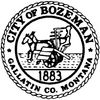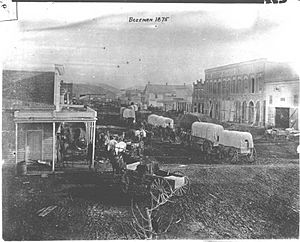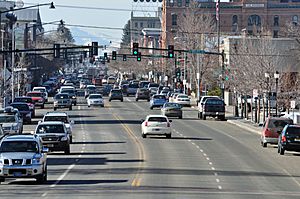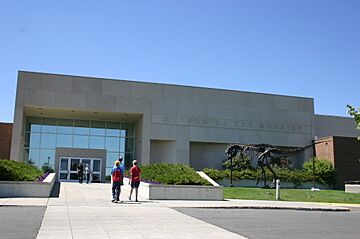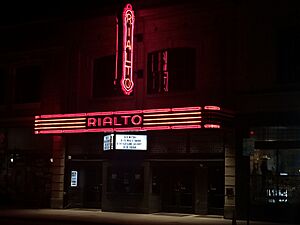Bozeman, Montana facts for kids
Quick facts for kids
Bozeman
|
|||
|---|---|---|---|
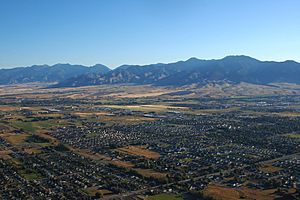
Aerial view of Bozeman
|
|||
|
|||
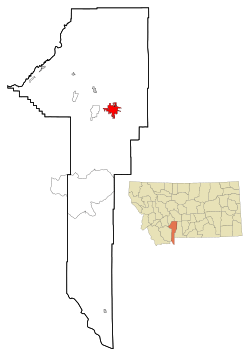
Location of Bozeman, Montana
|
|||
| Country | United States | ||
| State | Montana | ||
| County | Gallatin | ||
| Founded | August 9, 1864 | ||
| Named for | John Bozeman | ||
| Government | |||
| • Type | City commission/City manager | ||
| Area | |||
| • City | 20.91 sq mi (54.16 km2) | ||
| • Land | 20.86 sq mi (54.04 km2) | ||
| • Water | 0.05 sq mi (0.13 km2) | ||
| Elevation | 4,817 ft (1,468 m) | ||
| Population
(2020)
|
|||
| • City | 53,293 | ||
| • Estimate
(2022)
|
56,123 | ||
| • Density | 2,554.43/sq mi (986.26/km2) | ||
| • Metro | 118,960 | ||
| • Demonym | Bozemanite | ||
| Time zone | UTC−7 (MST) | ||
| • Summer (DST) | UTC−6 (MDT) | ||
| ZIP codes |
59715, 59717-59719, 59718, 59771-59772
|
||
| Area code(s) | 406 | ||
| FIPS code | 30-08950 | ||
| GNIS feature ID | 0769173 | ||
| Website | www.bozeman.net | ||
Bozeman (/ˈboʊzmən/ BOHZ-mən) is a city in and the county seat of Gallatin County, Montana, United States. Located in southwest Montana, the 2020 census put Bozeman's population at 53,293 making it the fourth-largest city in Montana. It is the principal city of the Bozeman, Montana, Micropolitan Statistical Area, consisting of all of Gallatin County with a population of 118,960. It is the fastest growing micropolitan statistical area in the United States in 2018, 2019 and 2020, as well as the second-largest of all Montana's statistical areas.
Contents
History
Early history
For many years, indigenous people of the United States, including the Shoshone, Nez Perce, Blackfeet, Flathead, Crow Nation and Sioux traveled through the area, called the "Valley of the Flowers". The Gallatin Valley in particular, in which Bozeman is located, was primarily within the territory of the Crow people.
19th century
William Clark visited the area in July 1806 as he traveled east from Three Forks along the Gallatin River. The party camped 3 miles (4.8 km) east of what is now Bozeman, at the mouth of Kelly Canyon. The journal entries from Clark's party briefly describe the future city's location.
John Bozeman
In 1863, John Bozeman, a pioneer and frontiersman from Pickens County, Georgia, along with a partner named John Jacob, opened the Bozeman Trail, a new northern trail off the Oregon Trail leading to the mining town of Virginia City through the Gallatin Valley and the future location of the city of Bozeman.
John Bozeman, with Daniel Rouse and William Beall, platted the town in August 1864, stating "standing right in the gate of the mountains ready to swallow up all tenderfeet that would reach the territory from the east, with their golden fleeces to be taken care of." Red Cloud's War closed the Bozeman Trail in 1868, but the town's fertile land still attracted permanent settlers.
Nelson Story
In 1866, Nelson Story, a successful Virginia City, Montana, gold miner originally from Ohio, entered the cattle business. Story braved the hostile Bozeman Trail to successfully drive some 1,000 head of longhorn cattle into Paradise Valley just east of Bozeman. Eluding the U.S. Army, who tried to turn Story back to protect the drive from hostile Indigenous Americans, Story's cattle formed one of the earliest significant herds in Montana's cattle industry. Story established a sizable ranch in the Paradise Valley and holdings in the Gallatin Valley. He later donated land to the state for the establishment of Montana State University.
Fort Ellis
Fort Ellis 45°39′16″N 110°56′35″W / 45.65444°N 110.94306°W, el. 4,987 feet (1,520 m) was established in 1867 by Captain R. S. LaMotte and two companies of the 2nd Cavalry, after the murder of John Bozeman near the mouth of Mission Creek on Yellowstone River 45°42′52″N 110°23′20″W / 45.71444°N 110.38889°W, and considerable political disturbance in the area led local settlers and miners to feel a need for added protection. The fort, named for Gettysburg casualty Colonel Augustus Van Horne Ellis, was decommissioned in 1886 and few remnants are left at the actual site, now occupied by the Fort Ellis Experimental Station of Montana State University. In addition to Fort Ellis, a short-lived fort, Fort Elizabeth Meagher (also simply known as Fort Meagher), was established in 1867 by volunteer militiamen. This fort was located 8 miles (12.9 km) east of town on Rocky Creek.45°38′30″N 110°55′05″W / 45.64167°N 110.91806°W, el. 5,249 feet (1,600 m)
Other
In 1864, W.W. Alderson described Gallatin County as "one of the most beautiful and picturesque valleys the eye ever beheld, abounding in springs of clear water." Many tended to agree, and Bozeman quickly garnered the nickname of "The Egypt" of Montana.
After incorporation, the first issue of the weekly Avant Courier newspaper, the precursor of today's Bozeman Chronicle, was published in Bozeman on September 13, 1871.
Bozeman's main cemetery, Sunset Hills Cemetery, was given to the city in 1872 when the English lawyer and philanthropist William Henry Blackmore purchased the land after his wife Mary Blackmore died of pneumonia in Bozeman in July 1872.
The first library in Bozeman was formed by the Young Men's Library Association in a room above a drugstore in 1872. It later moved to the mayor's office and was taken over by the city in 1890. The first Grange meeting in Montana Territory was held in Bozeman in 1873. The Northern Pacific Railway reached Bozeman from the east in 1883. By 1900, Bozeman's population had reached 3,500.
In 1892, the United States Commission of Fish and Fisheries established a fish hatchery on Bridger Creek at the entrance to Bridger Canyon. The fourth oldest fish hatchery in the United States, the facility ceased to be primarily a hatchery in 1966 and became the U.S. Fish and Wildlife Service's Bozeman National Fish Hatchery, later a fish technology and fish health center. The Center receives approximately 5,000 visitors a year observing biologists working on diet testing, feed manufacturing technology, fish diseases, brood stock development and improvement of water quality.
Bozeman was home to early minor league baseball. In 1892, Bozeman fielded a team in the Class B level Montana State League. In 1909, the Bozeman Irrigators played as members of the Class D level Inter-Mountain League. Both leagues disbanded.
Montana State University was established in 1893 as the state's land-grant college, then named the Agricultural College of the State of Montana. By the 1920s, the institution was known as Montana State College, and in 1965 it became Montana State University.
20th century
Bozeman's first high school, the Gallatin Valley High School, was built on West Main Street in 1902. Later known as Willson School, named for notable Bozeman architect Fred Fielding Willson, son of Lester S. Willson, the building still stands today and functions as administrative offices for the Bozeman School District.
In the early 20th century, over 17,000 acres (69 km2) of the Gallatin Valley were planted in edible peas harvested for both canning and seed. By the 1920s, canneries in the Bozeman area were major producers of canned peas, and at one point Bozeman produced approximately 75% of all seed peas in the United States. The area was once known as the "Sweet Pea capital of the nation" referencing the prolific edible pea crop. To promote the area and celebrate its prosperity, local business owners began a "Sweet Pea Carnival" that included a parade and queen contest. The annual event lasted from 1906 to 1916. Promoters used the inedible but fragrant and colorful sweet pea flower as an emblem of the celebration. In 1977 the "Sweet Pea" concept was revived as an arts festival rather than a harvest celebration, growing into a three-day event that is one of the largest festivals in Montana.
The first federal building and Post Office was built in 1915. Many years later, while unused, it became a film location, along with downtown Bozeman, in A River Runs Through It (1992) by Robert Redford, starring Brad Pitt. It is now used by HRDC, a community organization.
The Bridger Bowl Ski Area45°49′02″N 110°53′48″W / 45.81722°N 110.89667°W operates as a 501(c)(4) organization by the Bridger Bowl Association, and is located on the northeast face of the Bridger Mountains, utilizing state and federal land. Bridger Bowl was Bozeman's first ski area and opened to the public in 1955. In 1973 news anchorman Chet Huntley created the Big Sky Ski Resort off Gallatin Canyon 40 miles (64 km) south of Bozeman. The resort has grown considerably since 1973 into a residential community and major winter tourist destination.45°16′51″N 111°24′24″W / 45.28083°N 111.40667°W
In 1986, the 60-acre (24 ha) site of the Idaho Pole Co. on Rouse Avenue was designated a Superfund site and placed on the National Priorities List. Idaho Pole treated wood products with creosote and pentachlorophenol on the site between 1945 and 1997.
The Museum of the Rockies was created in 1957 as the gift from Butte physician Caroline McGill and is a part of Montana State University and an affiliate institution of the Smithsonian. It is Montana's premier natural and cultural history museum and houses permanent exhibits on dinosaurs, geology and Montana history, as well as a planetarium and a living history farm. Paleontologist Jack Horner was the museum's first curator of paleontology and brought national notice to the museum for his fossil discoveries in the 1980s.
Bozeman receives a steady influx of new residents and visitors in part due to its plentiful recreational activities, such as fly fishing, hiking, whitewater kayaking, and mountain climbing. Additionally, Bozeman is a gateway community through which visitors pass on the way to Yellowstone National Park and its abundant wildlife and thermal features. The showcasing of spectacular scenery and the Western way of life the area received from films set nearby, such as A River Runs Through It and The Horse Whisperer, have also served to draw people to the area.
21st century
From a rank of sixth in the early [19]80s, Bozeman has grown to become the fourth largest city in Montana. The area attracts new residents due to quality of life, scenery, and nearby recreation. In August 2010, Bozeman was selected by Outside as the best place to live in the west for skiing.
Growth in the Gallatin Valley prompted the Gallatin Airport Authority in 2009 to expand the Gallatin Field Airport with two new gates, an expanded passenger screening area, and a third baggage carousel. Subsequently, Gallatin Field was renamed Bozeman Yellowstone International Airport. Bozeman has been one of Montana's fastest growing cities from 1990 into the new millennium, currently growing at a fluctuating rate of 2-3% annually. If this trend continues, Bozeman could soon surpass Great Falls as Montana's third largest city.
Geography and climate
Bozeman is located at an elevation of 4,820 feet (1,470 m). The Bridger Mountains are to the north-northeast, the Tobacco Root Mountains to the west-southwest, the Big Belt Mountains and Horseshoe Hills to the northwest, the Hyalite Peaks of the northern Gallatin Range to the south and the Spanish Peaks of the northern Madison Range to the south-southwest. Bozeman is east of the continental divide, and Interstate 90 passes through the city. It is 84 miles (135 km) east of Butte, 125 miles (201 km) west of Billings, and 93 miles (150 km) north of Yellowstone National Park.
According to the United States Census Bureau, the city has a total area of 19.15 square miles (49.60 km2), of which 19.12 square miles (49.52 km2) is land and 0.03 square miles (0.08 km2) is water.
Bozeman experiences a humid continental climate (Köppen: Dfb) as it is located in a more humid microclimate setting. Bozeman and the surrounding area receive significantly higher rainfall than much of the central and eastern parts of the state, up to 24 inches (610 mm) of precipitation annually vis-à-vis the 8 to 12 inches (200 to 300 mm) common throughout much of Montana east of the Continental Divide. Combined with fertile soils, this means plant growth is relatively lush. This undoubtedly contributed to the Gallatin Valley's early nickname as the "Valley of the Flowers," as well as the establishment of Montana State University, the state's agricultural college, in the city. Bozeman has cold, snowy winters and relatively warm summers, though due to high elevation, temperature changes from day to night can be significant. The highest temperature ever recorded in Bozeman was 105 °F (40.6 °C) on July 31, 1892. The lowest recorded temperature, −46 °F (−43.3 °C), occurred in 1957 and also 1983.
Unlike most of the country, Bozeman has actually become cooler with the new 1991–2020 normals. Average highs dropped by 1.7 °F (0.94 °C), especially in spring and summer. It has also gotten wetter and snowier.
In 2019, Bozeman experienced unusually warm and dry temperatures during the month of December. Montana State University campus reported a daily average of 0.2 inches (5.1 mm) of precipitation for the month, some of the lowest numbers seen in over 120 years. Montana State University also recorded just over 3 inches (76.2 mm) of snowfall during December, the second lowest snowfall ever recorded. Additionally, maximum temperatures were 2 °F (1 °C) warmer and lowest temperatures were 6 °F (3 °C) above typical standards in previous Decembers. December 2023 has also been unusually warm and dry, in line with the country as a whole.
| Climate data for Bozeman, Montana (Montana State University), 1991–2020 normals, extremes 1892–present | |||||||||||||
|---|---|---|---|---|---|---|---|---|---|---|---|---|---|
| Month | Jan | Feb | Mar | Apr | May | Jun | Jul | Aug | Sep | Oct | Nov | Dec | Year |
| Record high °F (°C) | 65 (18) |
64 (18) |
75 (24) |
83 (28) |
91 (33) |
96 (36) |
105 (41) |
100 (38) |
99 (37) |
88 (31) |
73 (23) |
64 (18) |
105 (41) |
| Mean maximum °F (°C) | 51.6 (10.9) |
54.0 (12.2) |
63.7 (17.6) |
74.0 (23.3) |
79.8 (26.6) |
87.8 (31.0) |
93.2 (34.0) |
92.6 (33.7) |
87.7 (30.9) |
77.3 (25.2) |
62.4 (16.9) |
51.8 (11.0) |
94.8 (34.9) |
| Mean daily maximum °F (°C) | 34.2 (1.2) |
36.8 (2.7) |
46.1 (7.8) |
54.5 (12.5) |
63.2 (17.3) |
71.7 (22.1) |
82.1 (27.8) |
81.3 (27.4) |
71.4 (21.9) |
57.3 (14.1) |
42.3 (5.7) |
33.3 (0.7) |
56.2 (13.4) |
| Daily mean °F (°C) | 24.6 (−4.1) |
26.7 (−2.9) |
35.0 (1.7) |
42.5 (5.8) |
51.0 (10.6) |
58.6 (14.8) |
66.9 (19.4) |
65.6 (18.7) |
56.9 (13.8) |
44.9 (7.2) |
32.3 (0.2) |
23.9 (−4.5) |
44.1 (6.7) |
| Mean daily minimum °F (°C) | 15.1 (−9.4) |
16.6 (−8.6) |
23.9 (−4.5) |
30.5 (−0.8) |
38.8 (3.8) |
45.6 (7.6) |
51.7 (10.9) |
50.0 (10.0) |
42.4 (5.8) |
32.4 (0.2) |
22.2 (−5.4) |
14.5 (−9.7) |
32.0 (0.0) |
| Mean minimum °F (°C) | −10.3 (−23.5) |
−5.9 (−21.1) |
3.0 (−16.1) |
16.1 (−8.8) |
26.3 (−3.2) |
33.2 (0.7) |
41.6 (5.3) |
38.9 (3.8) |
29.5 (−1.4) |
13.9 (−10.1) |
−0.4 (−18.0) |
−9.0 (−22.8) |
−18.7 (−28.2) |
| Record low °F (°C) | −45 (−43) |
−43 (−42) |
−29 (−34) |
−10 (−23) |
16 (−9) |
26 (−3) |
32 (0) |
26 (−3) |
12 (−11) |
−10 (−23) |
−26 (−32) |
−46 (−43) |
−46 (−43) |
| Average precipitation inches (mm) | 0.86 (22) |
0.83 (21) |
1.42 (36) |
2.51 (64) |
2.93 (74) |
3.27 (83) |
1.33 (34) |
1.32 (34) |
1.44 (37) |
1.84 (47) |
1.25 (32) |
1.03 (26) |
20.03 (510) |
| Average snowfall inches (cm) | 12.7 (32) |
13.0 (33) |
13.1 (33) |
12.9 (33) |
3.6 (9.1) |
0.8 (2.0) |
0.0 (0.0) |
0.1 (0.25) |
0.4 (1.0) |
6.0 (15) |
12.5 (32) |
16.2 (41) |
91.3 (231.35) |
| Average precipitation days (≥ 0.01 in.) | 10.7 | 9.5 | 11.8 | 13.7 | 15.4 | 15.3 | 10.1 | 10.1 | 9.0 | 11.0 | 10.2 | 11.0 | 137.8 |
| Average snowy days (≥ 0.1 in.) | 9.2 | 8.4 | 8.4 | 6.7 | 1.5 | 0.2 | 0.0 | 0.0 | 0.2 | 3.0 | 7.1 | 9.4 | 54.1 |
| Source 1: NOAA | |||||||||||||
| Source 2: National Weather Service | |||||||||||||
Demographics
| Historical population | |||
|---|---|---|---|
| Census | Pop. | %± | |
| 1870 | 168 | — | |
| 1880 | 894 | 432.1% | |
| 1890 | 2,143 | 139.7% | |
| 1900 | 3,419 | 59.5% | |
| 1910 | 5,187 | 51.7% | |
| 1920 | 6,183 | 19.2% | |
| 1930 | 6,855 | 10.9% | |
| 1940 | 8,665 | 26.4% | |
| 1950 | 11,325 | 30.7% | |
| 1960 | 13,361 | 18.0% | |
| 1970 | 18,670 | 39.7% | |
| 1980 | 21,645 | 15.9% | |
| 1990 | 22,660 | 4.7% | |
| 2000 | 27,509 | 21.4% | |
| 2010 | 37,280 | 35.5% | |
| 2020 | 53,293 | 43.0% | |
| 2022 (est.) | 56,123 | 50.5% | |
| source: U.S. Decennial Census |
|||
2020 census
As of the census of 2020, there were 53,293 people and 22,041 households in the city. The population density of the city was 2,587.2 inhabitants per square mile (998.9/km2), a substantial increase since the 2010 census.
The racial makeup of the city was 88.6% White, 4.8% Hispanic or Latino, 2.4% Asian, 1.1% American Indian, and 0.6% Black. 5.6% of residents identified two or more races.
Of the 22,041 households in the city, each household has on average 2.24 people.
13.2% of Bozeman's population is under 18 years of age, and 10.7% of the population is over 65 years of age. 97.8% of the city's population, at or over the age of 25, has graduated high school or higher, and 64.2% of the population have attained at least a bachelor's degree. The gender makeup of the city is 53% male and 47% female.
The median income household income of the city was $74,113. The median per-capita income was $45,037. 14.7% of the population fell below the poverty line.
2010 census
As of the census of 2010, there were 37,280 people, 15,775 households, and 6,900 families residing in the city. The population density was 1,949.8 inhabitants per square mile (752.8/km2). There were 17,464 housing units at an average density of 913.4 per square mile (352.7/km2). The racial makeup of the city was 93.6% White, 0.5% African American, 1.1% Native American, 1.9% Asian, 0.1% Pacific Islander, 0.7% from other races, and 2.1% from two or more races. Hispanic or Latino of any race were 2.9% of the population.
There were 15,775 households, of which 21.3% had children under the age of 18 living with them, 33.1% were married couples living together, 7.0% had a female householder with no husband present, 3.6% had a male householder with no wife present, and 56.3% were non-families. 33.5% of all households were made up of individuals, and 7.6% had someone living alone who was 65 years of age or older. The average household size was 2.17 and the average family size was 2.80.
The median age in the city was 27.2 years. 15.7% of residents were under the age of 18; 28.2% were between the ages of 18 and 24; 31.4% were from 25 to 44; 16.7% were from 45 to 64; and 8.1% were 65 years of age or older. The gender makeup of the city was 52.6% male and 47.4% female.
Education
Public
Bozeman Public Schools has two components: Bozeman Elementary School District and Bozeman High School District. Belgrade Public Schools has two components: Belgrade Elementary School District and Belgrade High School District. Almost all of Bozeman is in Bozeman Elementary School District and Bozeman High School District. A small piece extends into Belgrade Elementary School District and Belgrade High School District.
- The Bozeman Public School District operates two high schools – Bozeman High School and Gallatin High School; two middle schools – Chief Joseph Middle School and Sacajawea Middle School; and eight elementary schools – Emily Dickinson Elementary School, Hawthorne Elementary School, Hyalite Elementary School, Irving Elementary School, Longfellow Elementary School, Meadowlark Elementary School, Morning Star Elementary School, and Whittier Elementary School.
- The district also operates the Bridger Alternative Program as a branch campus of Bozeman High School to serve "at-risk" secondary students.
- The former Emerson Elementary School is now a cultural community center. Willson School, originally a high school, then a middle school, then the base for an alternative high school, is still owned by the school district and houses a number of school district offices.
Private
- Mount Ellis Academy is a co-educational boarding high school (grades 9 through 12) affiliated with the Seventh-day Adventist Church.
- Headwaters Academy near the campus of Montana State University is a co-educational middle school (grades 6 through 8).
- Petra Academy is a co-educational school (grades pre-k through 12) affiliated with Protestant teachings.
Post-secondary
- Bozeman is home to Montana State University, the state's largest university and the flagship campus of the Montana State University System. MSU set a new fall enrollment record in the fall of 2018, at a total of 16,902 students on campus.
Media
- Newspapers and Magazines
- Bozeman Avant Courier – published 1871–1905
- The Republican-courier – published 1905–1913
- The Bozeman Courier – publisher 1919–1954
- Bozeman Daily Chronicle
- Bozeman Magazine is a free monthly publication.
- The BoZone Entertainment and Events Calendar has been publishing since 1993, a free biweekly publication owned by Bozeman Entertainment, LLC.
- The Montana Pioneer is a monthly newspaper of some decades' history, based in nearby Livingston but serving both areas.
- AM Radio
- KBOZ 1090, (Talk/Personality), Reier Broadcasting Company
- KOBB 1230, (sports talk), Reier Broadcasting Company
- KPRK AM 1340, (News/Talk), Townsquare Media
- KMMS 1450, (News/Talk), Townsquare Media
- KYWL AM 1490, (Active Rock)
- FM Radio
- KGLT 91.9, (Variety), Montana State University
- KMMS-FM 94.7, (Adult Album), Townsquare Media
- KISN 96.7, (Top 40 (CHR)), Townsquare Media
- KXLB 100.7, (Country music), Townsquare Media
- KBMC (FM) 102.1, (Variety), Montana State University-Billings
- KZMY 103.5, (Hot Adult Contemporary), Townsquare Media
- KBZM 104.7, (Classic Rock), Orion Media LLC
- KKQX 105.7, (Classic Rock), Orion Media LLC
- KSCY 106.9, (Country music), Orion Media LLC
- Defunct
- KOZB 97.5, (Classic rock), Reier Broadcasting Company
- KBOZ-FM 99.9, (Country music), Reier Broadcasting Company
- KOBB-FM 93.7, (Oldies), Reier Broadcasting Company
- Television
- KDBZ-CD 6 NBC, Sinclair Broadcast Group
- KBZK 7 CBS, E. W. Scripps Company
- KUSM 9 PBS, Montana State University
- KWYB-LD 28-1 ABC, Cowles Company (LP relay from Butte)
- KWYB-LD 28-2 FOX
Transportation
Bozeman straddles east-west Interstate 90 and is approximately 85 miles (137 km) east of north–south Interstate 15 in Butte, Montana. U.S. Highway 191 runs south from Bozeman to Big Sky and West Yellowstone. Montana Highway 86 runs north alongside the Bridger Range to U.S. 89. Montana Highway 84 runs west to U.S. 287 in Norris.
Freight rail service is provided by Montana Rail Link, a privately held Class II railroad that connects Spokane, Washington, with Huntley, Montana. The city was last served by passenger rail in 1979 by the North Coast Hiawatha at Bozeman Depot.
Bozeman has operated a zero-fare public bus system called Streamline since 2006. Streamline operates six routes, covering the university, Bozeman-Deaconess Hospital, Gallatin Valley Mall, 7th Avenue and 19th Avenue shopping areas, downtown, service to Belgrade, and (seasonally) service to Livingston. The system is funded by a variety of federal, state, and local sources. The Gallatin Big Sky Transportation District has operated the Skyline bus service between Bozeman and Big Sky since December 2006.
Intercity bus service to the city is provided by Jefferson Lines.
One of the three major regional airports serving southwest Montana is Bozeman Yellowstone International Airport west of Bozeman on the outskirts of Belgrade, Montana. It primarily serves travelers to Bozeman, Big Sky, West Yellowstone and Yellowstone National Park. A smaller commercial airport is located in West Yellowstone, 90 mi (140 km) south of Bozeman.
Notable people
The following individuals are either notable current or former residents of Bozeman (R), were born or raised in Bozeman in their early years (B), or otherwise have a significant connection to the history of the Bozeman area (C).
- Sports personalities
- Conrad Anker, mountaineer C
- Brock Coyle, linebacker for San Francisco 49ers, Seattle Seahawks B
- Will Dissly, tight end for Seattle Seahawks B
- Jeff Fisher, Head Coach for Tennessee Titans and Los Angeles Rams R
- Nikki Kimball, distance runner R
- Dane Fletcher, linebacker for New England Patriots, Tampa Bay Buccaneers B
- Alex Lowe, ice-climber and alpinist R
- Darren Main, yoga instructor R
- Mike McLeod, former NFL safety B
- Heather McPhie, freestyle skier, member of 2010 US Olympic team B
- Phil Olsen, former National Football League lineman R
- Willie Saunders, Bozeman-born Canadian Horse Racing Hall of Fame jockey, won U.S. Triple Crown B
- Jan Stenerud, member of Pro Football Hall of Fame, AFL and NFL placekicker for Kansas City Chiefs, Green Bay Packers and Minnesota Vikings; winner of Super Bowl IV R
- Kevin Sweeney, former quarterback for Dallas Cowboys B
- Tejay van Garderen, professional cyclist R
- Military and pioneers
- Travis Atkins, Medal of Honor recipient R
- John Bozeman, pioneer and founder of the Bozeman Trail C
- Gustavus Cheyney Doane, member of Washburn-Langford-Doane Expedition 1870 and buried in Sunset Hills Cemetery, Bozeman
- Nelson Story, prominent cattleman and merchant in Bozeman's early years R
- Lester S. Willson, prominent merchant in Bozeman's early years R
- Arts, culture and entertainment
- Kris Atteberry, MLB broadcaster, one of only two Montanans to call an MLB game B
- Brannon Braga, writer and producer of Star Trek television shows and films B
- Deborah Butterfield, sculptor known for use of horses in artwork R
- Gary Cooper, film actor, attended Gallatin Valley High School in Bozeman R
- Daniella Deutscher, actress B
- Pablo Elvira, opera singer R
- Landon Jones, journalist and author R
- Donna Kelley, former CNN anchor and current KBZK anchor. R
- Jane Lawrence, actress and opera singer B
- Jason Lytle, lead singer of Modesto band, Grandaddy; solo artist R
- Julian MacKay, ballet dancer B
- Ben Mikaelsen, author R
- Christopher Parkening, guitarist, fly casting champion R
- David Quammen, long-time columnist for Outside magazine, and author R
- Steven Rinella, American outdoorsman, conservationist, writer, and television personality
- Albert, Alfred and Chris Schlechten multi-generation family of photographers noted for portraiture and images of Yellowstone National Park and the Gallatin Valley. R, R, B
- James Willard Schultz, author and Glacier National Park explorer, lived in Bozeman 1928–1929 with partner Jessica McDonald, professor at Montana State; R Schultz's papers are archived at Montana State Burlingame Special Collections Library.
- Michael Spears, actor R
- Eddie Spears, actor R
- Julia Thorne, writer and ex-wife of 2004 Democratic Presidential candidate John Kerry R
- Kathy Tyers, writer, particularly known for contribution to Star Wars series R
- Peter Voulkos, ceramic artist B
- Sarah Vowell, author, regular on This American Life, voice actress from The Incredibles, B
- Dave Walker, musician R
- Science and academia
- Loren Acton, astronaut and physicist R
- Sidney M. Cadwell, discoverer of anti-oxidants for rubber, made first scientific study of rubber's fatigue behavior. B
- Don G. Despain, botanist, ecologist, and fire behavior specialist R
- Christopher Langan, scientist was born in San Francisco but grew up mostly in Bozeman
- Diana L. Eck, Professor of Comparative Religion at Harvard University B
- Dr. James A. Henshall, first superintendent of Bozeman Fish Technology Center C
- Alice Haskins, government botanist and professor R
- Jack Horner, preeminent paleontologist upon whom main character, Dr. Alan Grant, in book and film Jurassic Park was patterned R
- Dale W. Jorgenson, Harvard University professor and economist B
- Robert M. Pirsig, author and past instructor of English and rhetoric at Montana State University R
- Ann Linnea Sandberg, immunologist R
Business and industry
Bozeman's top employers include Bozeman Health, Montana State University, Simms Fishing Products and Mystery Ranch as well as at least two dozen high-tech companies engaged in research or production of lasers and other optical equipment, over a dozen bio-tech companies, and several large software companies. Nationally known companies based in Bozeman include ILX Lightwave (an MKS/Newport company), Quantel USA, RightNow Technologies, Snowflake Inc., Schedulicity, Workiva, onX and Simms Fishing Products. Notable non-profit organizations based in Bozeman include the Greater Yellowstone Coalition, Human Resource Development Council (HRDC) and Eagle Mount.
Points of interest
- Museums and gardens
- American Computer Museum
- Gallatin Historical Society-The Pioneer Museum
- Montana Arboretum and Gardens
- Museum of the Rockies
- Story Mansion
- Libraries
- Bozeman Public Library
- Renne Library, Montana State University
- Ski areas
- Universities and colleges
- Other
- BZN International Film Festival
- East Gallatin Recreation Area
- Gibson Guitar Factory
- Hyalite Canyon and Reservoir
- Sweet Pea-A Festival of the Arts – Festival held annually since 1977. The Sweet Pea Carnival was first established in 1906.
- U.S. Fish and Wildlife Service Fish Technology Center, established 1892
See also
 In Spanish: Bozeman para niños
In Spanish: Bozeman para niños



